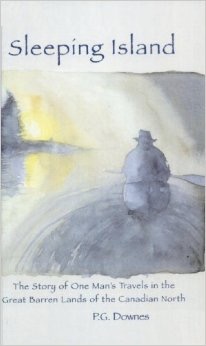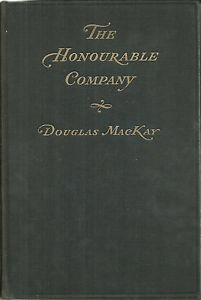November 2014
Sleeping Island
10/11/14 09:12
P.G. Downes: Sleeping Island (N. Ferrisburg, VT: Heron Dance Press, 2004)

The time just before and just after the Second World War were years of opening of the great Canadian Barrens. Previously largely inaccessible, the advent of airplanes and outboard motors made travel over longer distances possible and gave new access to extremely remote places. P.G. Downes seemed to have the ability to not only undertake the still-great adventures, but also to forge connections with the people.
In this book Downes is not so much making the report of a trip, which he does, but more importantly making a plea for a way of life that was rapidly disappearing, with a great deal of human suffering accompanying the disappearance. It is more than a book about exciting wilderness canoe travel. It is a book about the people Downes met along the way. Respect for the people and love of the land are qualities that ring through Downes words.
The book is, in many ways, a classic. I’m glad I found a copy to read and to own.
The Lonely Land
10/11/14 09:04
Sigurd F Olson: The Lonely Land (Minneapolis: University of Minnesota Press, 1997)

I often think of Olson as a writer of the boundary waters region, but this book takes us on an adventure much farther north to places much more remote. A thousand miles northwest of Lake Superior, this is still fairly wild country. A 500-mile trip through this area would be a major expedition in today’s world. Olson and his companions not only had one wonderful adventure, he reported it in this book in a manner that is fresh and wonderful.
#primary-container
I love to read, but I tend to get behind in my reports. I guess some things haven't changed since elementary school. I tend to get a stack of books that I have read and then write several reports all at once. At any rate, part of getting to know me is to know a little about what I am reading. So here are some of the books that I have been reading.
The Honourable Company
10/11/14 06:57
Douglas MacKay: The Honourable Company: A History of The Hudson’s Bay Company (London: Cassell and Company, Ltd., 1937)

Chartered in 1670, it wasn’t until the 1930’s - nearly 300 years after the company was founded that an authorized history of the company was allowed. Douglas MacKay’s volume tells a story that had not been previously told. Now that there are newer, and perhaps more complete histories of the company, it still is valuable to take a look at MacKay’s report. I will be reading a couple of other histories of the company, but this comprehensive and detailed report gives insights into the people who pioneered the company.
The volume reflects some antiquated ideas and thoughts about Indigenous People and it lacks some of the respect that we expect in contemporary times, but even this illustrates the company and how it came to have control over the livelihoods and very lives of people.
It is a fascinating read and a book I’ll keep on my shelves as a general reference as I continue to read and learn more of the history of our northern neighbors.